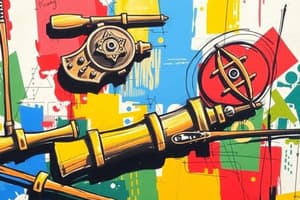Podcast
Questions and Answers
What was a primary contribution of women during the Revolutionary War?
What was a primary contribution of women during the Revolutionary War?
- Leading troops in strategic planning and military tactics
- Supporting soldiers through tasks like cooking and medical care (correct)
- Engaging in combat operations directly on the battlefield
- Documenting war events for future historical accounts
Who was identified as the artist of the unsigned masterpiece?
Who was identified as the artist of the unsigned masterpiece?
- Amedeo Modigliani
- Pierre Eugene du Simitiere (correct)
- Skic
- Hernstadt
In what year was the sketch put on public display?
In what year was the sketch put on public display?
- 2024 (correct)
- 2022
- 2025
- 2023
What aspect of the Continental Army does the sketch help to illustrate?
What aspect of the Continental Army does the sketch help to illustrate?
Why have the efforts of women during this period often been overlooked?
Why have the efforts of women during this period often been overlooked?
What significant historical realization did Judith Hernstadt have about her sketch after 40 years?
What significant historical realization did Judith Hernstadt have about her sketch after 40 years?
How did Matthew Skic initially assess the authenticity of the sketch's materials?
How did Matthew Skic initially assess the authenticity of the sketch's materials?
Which army's shirt did Skic identify on one of the soldiers in the sketch?
Which army's shirt did Skic identify on one of the soldiers in the sketch?
What did the blurry text on the sketch indicate about the depicted wagon?
What did the blurry text on the sketch indicate about the depicted wagon?
What was the historical event that coincided with the North Carolina army's march through Philadelphia?
What was the historical event that coincided with the North Carolina army's march through Philadelphia?
What role did the depicted women in the sketch play during the Revolutionary War?
What role did the depicted women in the sketch play during the Revolutionary War?
How did Skic feel about the significance of the drawing upon observing the soldier's shirt?
How did Skic feel about the significance of the drawing upon observing the soldier's shirt?
What was Judith Hernstadt's primary motivation for inviting Matthew Skic to view her collection?
What was Judith Hernstadt's primary motivation for inviting Matthew Skic to view her collection?
Flashcards
Revolutionary War Women
Revolutionary War Women
Women who provided crucial support to soldiers during the Revolutionary War, often overlooked in historical accounts.
Pierre Eugene du Simitiere
Pierre Eugene du Simitiere
The artist who created the unsigned sketch depicting daily life in the Continental Army.
The Continental Army Sketch
The Continental Army Sketch
A drawing illustrating the everyday activities of soldiers in the Continental Army during the Revolutionary War.
Understanding Soldier Life
Understanding Soldier Life
Signup and view all the flashcards
Donating Historical Artifacts
Donating Historical Artifacts
Signup and view all the flashcards
What is the subject of the sketch?
What is the subject of the sketch?
Signup and view all the flashcards
Why is the sketch historically significant?
Why is the sketch historically significant?
Signup and view all the flashcards
Who are the women in the sketch?
Who are the women in the sketch?
Signup and view all the flashcards
What materials were used for the sketch?
What materials were used for the sketch?
Signup and view all the flashcards
Who discovered the significance of the sketch?
Who discovered the significance of the sketch?
Signup and view all the flashcards
How was the sketch linked to a specific event in history?
How was the sketch linked to a specific event in history?
Signup and view all the flashcards
What does the sketch reveal about the life of soldiers?
What does the sketch reveal about the life of soldiers?
Signup and view all the flashcards
How does the sketch contribute to the understanding of history?
How does the sketch contribute to the understanding of history?
Signup and view all the flashcards
Study Notes
Revolutionary War Sketch Discovery
- Judith Hernstadt, an 18th-century artifact collector, owned a Revolutionary War sketch.
- The sketch depicted two women, a baby, and six soldiers in a horse-drawn carriage.
- It included rough drafts of two men.
- The sketch was a 15 by 5 inch (38 by 12.7 cm) pen-and-ink drawing.
- It took 40 years for the sketch's historical significance to be recognized.
Discovery and Investigation
- In August 2023, Hernstadt showed the sketch to Matthew Skic, a museum curator.
- Skic recognized a Continental Army uniform on one soldier.
- The sketch's inscription mentioned a North Carolina Brigade wagon's route through Philadelphia in August 1777.
- This coincided with an old newspaper report detailing the North Carolina troops' march to join General Washington's army before the Battle of Brandywine.
- Skic confirmed the paper and ink were from the Revolutionary era.
Historical Significance
- The sketch is the first known wartime drawing of the North Carolina troops by an eyewitness.
- It's one of only two known artworks featuring female followers of the Continental Army.
- These women supported soldiers with tasks like cooking, chores, and medical care.
- Their roles are often overlooked in history.
- The sketch provides insight into the Continental Army's daily operations, including joy, hardship, and routines.
Artist Identification
- The sketch's artist was identified as Pierre Eugene du Simitiere.
- Du Simitiere, a Swiss artist, arrived in Philadelphia in 1774 and was known for Revolutionary War sketches.
- Hernstadt donated the sketch to the museum.
- The sketch was publicly displayed in April 2024.
Studying That Suits You
Use AI to generate personalized quizzes and flashcards to suit your learning preferences.





